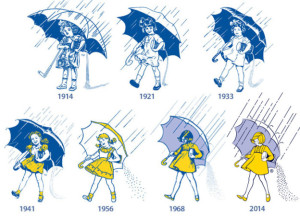“When it rains, it pours.” It’s the 100th birthday of the Morton Salt Girl, but she looks fabulous for her age. Okay, the icon got a little makeover this year, but every girl is entitled to a little pampering now and then, right?
Over the years she’s branched out to sea salt, kosher salt, popcorn salt, and on and on, but she’s still happily dumping product and profits out onto the street. Morton Salt still pours.
Throughout most of the 20th century, by simply establishing a consistent brand and consistent quality, a marketer could establish brand loyalty. It was all so simple.
Then in 1962, a 34-year-old artist changed everything. Andy Warhol made a silk screen painting of a giant Campbell’s soup can. And then he made another and another and another. He was inspired by the way products were lined up in the now ubiquitous supermarkets. Images he thought are now mass produced and repeated again and again in our minds. By taking the soup can out of its native environment and putting it in another context — the art gallery — he made the point that brand familiarity breeds fatigue.
This is why Warhol suggested that, in the future, everyone will be famous for a metaphorical 15 minutes. The emphasis is on the word “everyone.” Regardless of how long it takes the flame to flicker, each new thing will in turn demand the spotlight.
This of course explains all of those “New and Improved!” designations, co-branding, new packaging, sodium free versions, lite versions, organic versions, and gluten-free versions, and even ever-so-slightly altered labels. While today’s Campbell’s soup label is similar to Warhol’s 1962 version, it’s not quite the same. And as I said, our Morton Salt girl had some work done just this year.
It’s the brand manager’s chief dilemma. It’s like walking to the edge of cliff and peering over. How do you eek out another minute or two of fame while maintaining that consistent quality and brand familiarity?
Warhol demonstrates the answer. In 1962 a soup label on the grocery store shelf got very little attention, but soup labels in the art gallery garnered huge attention, and remarkably they became an inseparable part of Warhol’s brand. The difference is not the brand itself but the context in which we find it. Or as Marshall McLuhan said in his 1964 book, Understanding Media: The Extensions of Man, “the medium is message.”
The goal is to constantly put your marketing in new contexts. Once it was billboards and magazine ads and point-of-purchase. Of course there also was telemarketing, and direct mail, and then email. But ultimately email became spam and spam became social media. Perhaps the next big thing will be retro and everyone will be hiring skywriters.
Regardless, you can capture your audiences’ attention not by altering the brand, but by rethinking the context in which they find it. Surprise them, delight them, but be ever faithful. Be the brand they’ve come to know and love, but put it in a whole new light.
This article was syndicated from Business 2 Community: Keep Your Brand Current, But Be Faithful To It
More Sales & Marketing articles from Business 2 Community:
- 5 Traits Of Customer-Focused Companies
- 5 Ways UX Design Improves Inbound Marketing
- The Three Proven Customer Service Attributes that Drive Loyalty
- What Can Inbound Marketing Do For You In 2015?
- How To Deal With Angry, Frustrated Or Complaining Customers On Social Media (And Not Let It Affect Your Brand)




